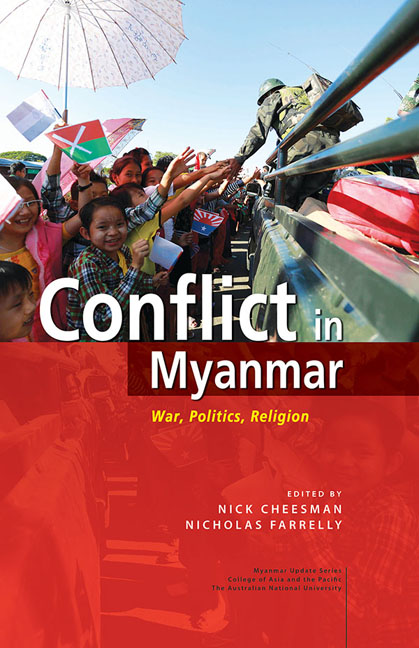Book contents
- Frontmatter
- Contents
- List of Maps
- List of Tables
- List of Figures
- Acknowledgements
- Contributors and Editors
- Part I Introduction
- Part II War and Order
- 2 The politics of policymaking in transitional government: A case study of the ethnic peace process in Myanmar
- 3 Reexamining the centrality of ethnic identity to the Kachin conflict
- 4 A feminist political economy analysis of insecurity and violence in Kachin State
- 5 Pacifying the margins: The Pa-O Self-Administered Zone and the political order in southern Shan State
- 6 Landmines as a form of community protection in eastern Myanmar
- Part III Elections and After
- Part IV Us and Them
- Part V Conclusion
- Abbreviations and Key Terms
- Index
3 - Reexamining the centrality of ethnic identity to the Kachin conflict
from Part II - War and Order
Published online by Cambridge University Press: 22 July 2017
- Frontmatter
- Contents
- List of Maps
- List of Tables
- List of Figures
- Acknowledgements
- Contributors and Editors
- Part I Introduction
- Part II War and Order
- 2 The politics of policymaking in transitional government: A case study of the ethnic peace process in Myanmar
- 3 Reexamining the centrality of ethnic identity to the Kachin conflict
- 4 A feminist political economy analysis of insecurity and violence in Kachin State
- 5 Pacifying the margins: The Pa-O Self-Administered Zone and the political order in southern Shan State
- 6 Landmines as a form of community protection in eastern Myanmar
- Part III Elections and After
- Part IV Us and Them
- Part V Conclusion
- Abbreviations and Key Terms
- Index
Summary
Myanmar has been plagued by armed conflict since independence. Kachin armed resistance, the focus of this chapter, has challenged the state since 1962, now more than half a century. Initial independence claims have been revised to demands for a federal union, but recourse to armed resistance to secure full or partial autonomy constitutes an explicit or implicit separatist claim. The conventional characterization of separatist conflicts in Myanmar, including the Kachin conflict, has focused on centre-periphery ethno-nationalist politics (for example, Egreteau 2012; Smith 1991, 1997, 2007; South 2008). The idea that ‘ethnic’ identity is primary has largely been taken for granted, and analysis has predominantly focused on the structure and patterns of inequality in inter-ethnic relations. This chapter reframes that presupposition.
For all its faults, the previous military government achieved some form of ceasefire deal with forty armed groups between 1998 and 2010 (Min Zaw Oo 2014). One of the most significant of these was the 1994 ceasefire with the Kachin Independence Organisation (KIO) and its armed wing, the Kachin Independence Army (KIA). The KIO/A are one of the larger, better organized and more formidable of the non-state armed groups, with a presence spread across a significant part of Kachin and northern Shan States, and while the other ceasefire deals were unwritten ‘gentlemen's agreements’, the Kachin ceasefire was the only one with a signed document (although the signed document was kept secret for a decade). For most of its seventeen years, the Kachin ceasefire also appeared among the most stable and led to a wealth of state-led, civil society and commercial development activity, including the rapid expansion of resource extraction.
Since the return to armed conflict by the KIO/A in June 2011, and their recalcitrant stance in national ceasefire negotiations, analysis has begun to emphasize the growing role of resource exploitation, and it has been tempting to characterize this as a resource-driven conflict. Certainly, almost all violent clashes between the Tatmadaw and the KIA since 2011 have centred around the control of resources and resource trade corridors, suggesting it is pertinent to once again re-examine the causes and characteristics of the Kachin conflict.
- Type
- Chapter
- Information
- Conflict in MyanmarWar, Politics, Religion, pp. 47 - 66Publisher: ISEAS–Yusof Ishak InstitutePrint publication year: 2016



